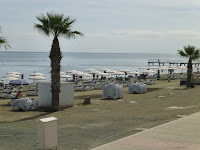Larnaca sits on the south coast of Cyprus and was originally founded in the 9th century. Originally built on the what used to be Kition. Today Λάρνακα is the third-largest city on the island with with a population just over 84,500.
 Foinikoudes is the palm tree lined promenade along the beach.
Foinikoudes is the palm tree lined promenade along the beach.

 Foinikoudes is the palm tree lined promenade along the beach.
Foinikoudes is the palm tree lined promenade along the beach. 
There's a bust of Kimon the Athenian, the mid 5th century BC statesman who founded the famous Stoic school of philosophy.

The Church of Saint Lazarus was built in the late 9th century. The church is supposed to be built over the second tomb of Lazarus of Bethany who, in the New Testament, Jesus raised from the dead.
 The Medieval castle was founded in the 12th century by the Byzantines. Today it hosts a museum and a garden theatre.
The Medieval castle was founded in the 12th century by the Byzantines. Today it hosts a museum and a garden theatre.

The Larnaca town hall is on the promenade between a KFC and a T.G.I. Friday's.

The Mosque of Umm Haram, also known as Hala Sultan Tekke, is a shrine on the west bank of the Larnaca Salt Lake. It was built in 1787 and it is one of the most important holy places in Islam. The mosque is built over the tomb of Umm Haram who was the Prophet Mohammed's wet nurse.
 The Larnaca Salt Lake has a surface area of 2.2 km² and is a protected area. The lake is a stop on the migratory path of the greater flamingo so it's popular with birdwatchers. In winter the lake fills with water that evaporates in the summer leaving a crust of salt.
The Larnaca Salt Lake has a surface area of 2.2 km² and is a protected area. The lake is a stop on the migratory path of the greater flamingo so it's popular with birdwatchers. In winter the lake fills with water that evaporates in the summer leaving a crust of salt.

The Armenian Genocide Memorial marks the spot where thousands of refugees fleeing the Armenian Genocide first landed in Cyprus. The monument was unveiled in 2008 and is dedicated to both the martyrs and survivors of the 1915-1923 Genocide.

The Panagia Angeloktisti is an 11th century Byzantine church. Legend has it that angels came down from heaven and built the church at night.
 The Kamares Aqueduct was built in 1747. Also known as the Bekir Pasha Aqueduct, it is regarded as the most important thing constructed during the Ottoman period in Cyprus.
The Kamares Aqueduct was built in 1747. Also known as the Bekir Pasha Aqueduct, it is regarded as the most important thing constructed during the Ottoman period in Cyprus.

 The Medieval castle was founded in the 12th century by the Byzantines. Today it hosts a museum and a garden theatre.
The Medieval castle was founded in the 12th century by the Byzantines. Today it hosts a museum and a garden theatre.

 The Larnaca Salt Lake has a surface area of 2.2 km² and is a protected area. The lake is a stop on the migratory path of the greater flamingo so it's popular with birdwatchers. In winter the lake fills with water that evaporates in the summer leaving a crust of salt.
The Larnaca Salt Lake has a surface area of 2.2 km² and is a protected area. The lake is a stop on the migratory path of the greater flamingo so it's popular with birdwatchers. In winter the lake fills with water that evaporates in the summer leaving a crust of salt. 
The Armenian Genocide Memorial marks the spot where thousands of refugees fleeing the Armenian Genocide first landed in Cyprus. The monument was unveiled in 2008 and is dedicated to both the martyrs and survivors of the 1915-1923 Genocide.

 The Kamares Aqueduct was built in 1747. Also known as the Bekir Pasha Aqueduct, it is regarded as the most important thing constructed during the Ottoman period in Cyprus.
The Kamares Aqueduct was built in 1747. Also known as the Bekir Pasha Aqueduct, it is regarded as the most important thing constructed during the Ottoman period in Cyprus.




























No comments:
Post a Comment